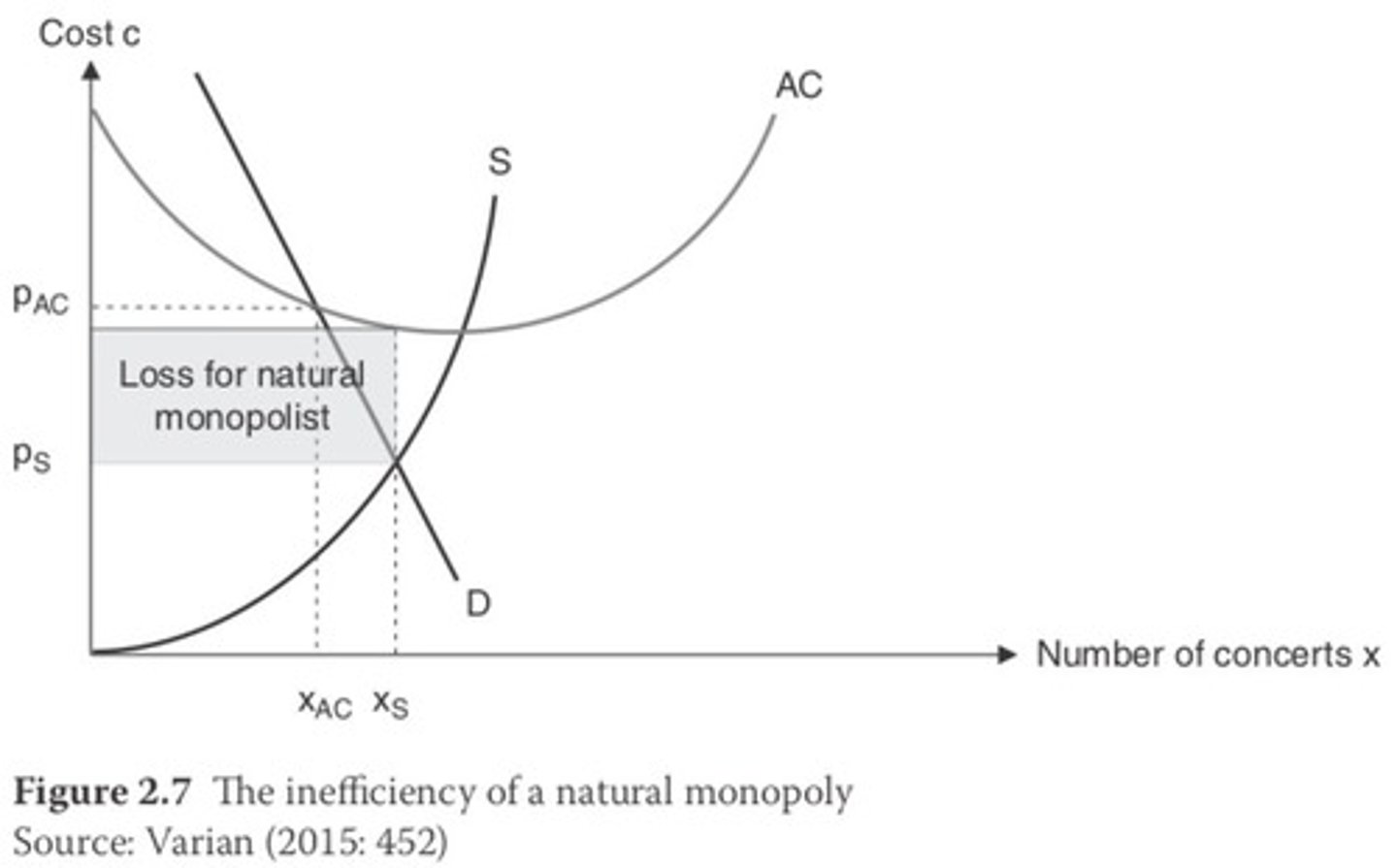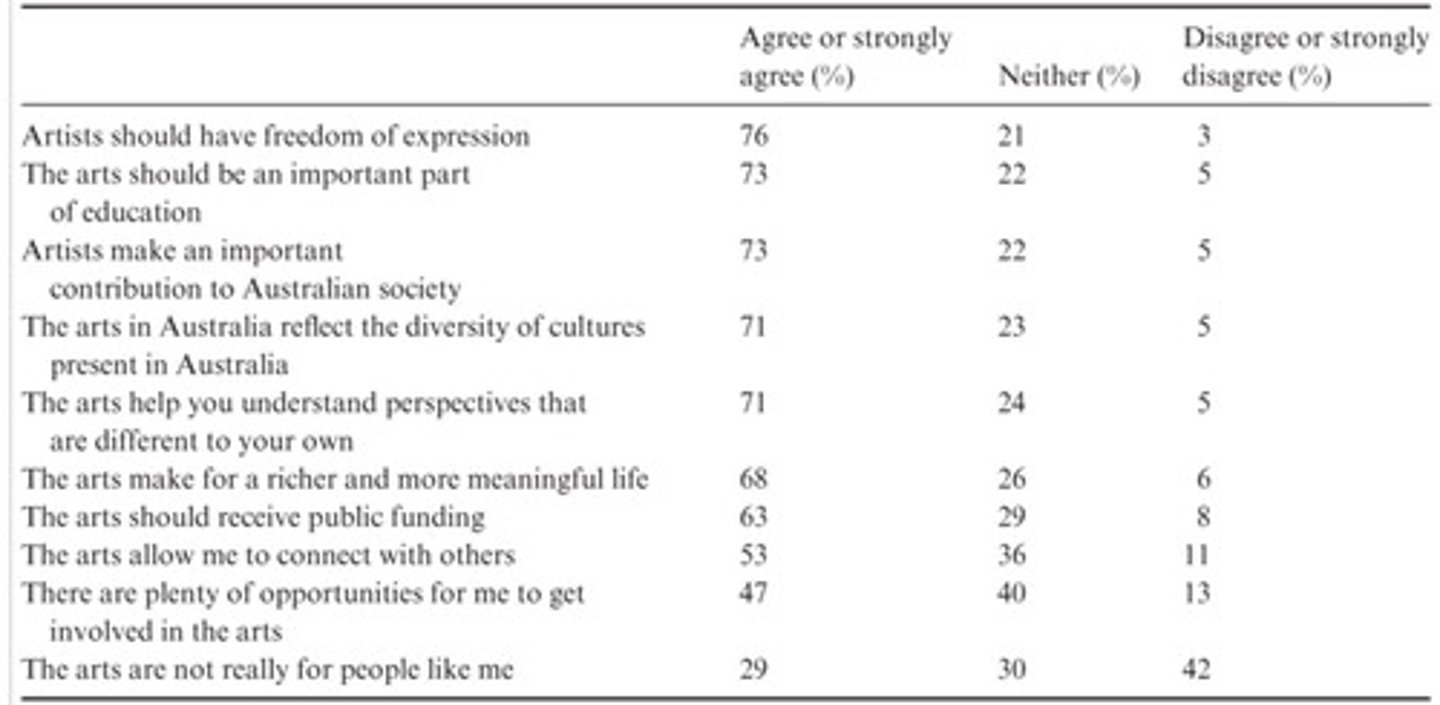Economics of Art & Culture: Public Goods, Externalities, and Funding Arguments
1/146
There's no tags or description
Looks like no tags are added yet.
Name | Mastery | Learn | Test | Matching | Spaced |
|---|
No study sessions yet.
147 Terms
What is the main question regarding government involvement in the arts?
Should the government subsidize the arts?
What are the two main types of arguments for funding the arts?
Efficiency and equity
What does the efficiency argument for arts funding address?
Market failures that create opportunities for government policy intervention.
What are positive externalities in the context of the arts?
Benefits that affect third parties and are not reflected in market prices.
What is a public good?
A good that is nonrival and nonexclusive, meaning consumption by one does not reduce availability for others.
What does the equity argument for arts funding focus on?
Redistributing income to ensure everyone can access a minimum fair share of the arts.
What is Pareto Efficiency?
A situation where one cannot improve one individual's situation without harming another.
What is the role of the National Endowment for the Arts (NEA)?
To provide grants that help redistribute income for access to the arts.

What are the seven assumptions of a perfectly competitive market?
Many buyers and sellers, homogeneous products, free entry and exit, perfect information, no externalities, no public goods, and no transaction costs.
What does it mean for buyers and sellers to act as price-takers?
They accept the market price as given and cannot influence it.
What is the Law of One Price?
In a perfectly competitive market, identical goods must sell for the same price.
What is the significance of marginal utility in demand?
It reflects the additional satisfaction gained from consuming one more unit of a good.
What does marginal cost represent in supply?
The cost of producing one more unit of a good, which typically increases with output.
What is the condition for maximizing welfare in a market?
When price equals marginal cost (P = MC).
What is market failure?
A situation where the allocation of goods and services is not efficient.

What are some conditions leading to market failure?
Concentrated structure, differentiated products, barriers to entry, externalities, public goods, asymmetric information, and transaction costs.
What is a monopoly?
A market structure where a single seller controls the entire market.
What is oligopoly?
A market structure characterized by a few large sellers dominating the market.
What is asymmetric information?
A situation where one party has more or better information than another in a transaction.
What is a merit good?
A good that is deemed beneficial for individuals and society, justifying government subsidies.
What is the role of public finance in arts funding?
To levy taxes and distribute funds to support the arts and culture.
What are the implications of free entry in a perfectly competitive market?
If a market is profitable, new firms are expected to enter, increasing competition.
What is the impact of diminishing returns on supply?
As firms increase output, the cost of producing additional units typically rises.
What is the significance of government intervention in the arts?
To correct market failures and ensure equitable access to cultural resources.
What are club goods?
Goods that are excludable but nonrival, meaning consumption can be limited to members but does not diminish availability.
What are the potential downsides of subsidizing the arts?
It may not benefit society or artists effectively, and government may not manage the process well.
What is a monopoly in the context of market failures?
A situation where a single entity restricts quantity and charges a price greater than marginal cost.

How do ©-based creative industries typically operate?
They are usually for-profit and characterized by monopolistic competition with continuous imitation and free entry.
What is a common characteristic of large US cities regarding arts institutions?
They often have just one art museum, symphony orchestra, opera, or ballet company.
Why might nonprofits in the arts charge a price greater than marginal cost?
It may be due to average cost being greater than marginal cost in a declining cost industry.
What are positive externalities?
Benefits conferred on society that are not captured by the market, such as increased literacy from education.
How can arts be compared to education regarding external benefits?
Both can provide private benefits to individuals and external benefits to society.
What does MEB stand for?
Marginal External Benefit.
What does DWL represent in economic terms?
Deadweight Loss, indicating inefficiencies in the market where the quantity produced is less than socially optimal.
What is a potential justification for subsidizing the arts?
If the arts generate external benefits and are produced in insufficient quantities.
What is Cultural Capital according to Throsby (1999)?
The stock of cultural value embodied in an asset, which can be tangible or intangible.
What is the debate surrounding the preservation of monuments and controversial books?
Whether they should be removed, renamed, or preserved due to their cultural significance.
What is one argument for maintaining cultural assets for future generations?
It is a way to bequeath cultural value to future generations who may benefit from it.
How can arts contribute to national identity and prestige?
By fostering pride in cultural achievements and international recognition of artists.
What is Economic Impact Analysis (EIA)?
A method used to measure the incremental effects of an event or related facilities on the local economy.
What is the potential impact of arts activity on the local economy?
It may generate spillover benefits to other producers and attract new firms.
What is the purpose of Cost-Benefit Analysis (CBA)?
To measure the costs and benefits of a specific project and calculate its rate of return compared to other projects.
What does the time value of money refer to in CBA?
The concept that future benefits should be discounted to reflect their present value.
What are private costs in a project?
The estimated costs of the building project and maintenance over time.
What are external costs in a project?
Costs that are more difficult to quantify, such as disruption to city life and congestion caused by construction.
What are private benefits in the context of a museum?
Anticipated revenues from visitor entrance fees and profits from other direct expenditures by visitors.
What is the significance of estimating future benefits in CBA?
It helps to compare them with the costs of the initial outlay and ongoing maintenance over the project's lifetime.
What does QSOC represent in the context of positive externalities?
The socially desirable quantity of a good that should be produced.
What is the relationship between MPB and MEB in the context of the arts?
MPB (Marginal Private Benefit) is the direct benefit to consumers, while MEB (Marginal External Benefit) reflects the broader societal benefits.
What is a controversial aspect of subsidizing the arts?
Whether the external benefits justify the use of taxpayer money for arts subsidies.

What is the argument against national intervention for local arts benefits?
Local benefits may not justify national subsidies, as they primarily affect local communities.
What is the role of cultural amenities in attracting firms?
They may help cities attract new firms, contributing to job creation and economic stability.
What is the primary purpose of Cost-Benefit Analysis (CBA)?
To compare the estimated internal rate of return for projects to make public spending decisions easier.
What does Economic Impact Studies (EIS) take into account that CBA does not?
External private effects on other producers and external benefits to consumers.
What is an example of an externality in production?
A café benefiting from increased customers due to a nearby museum opening.
What key factor must be considered in EIS regarding government financing?
How localized the planning is and who will benefit from the project.
What does EIS measure in terms of visitor benefits?
Private benefits from direct expenditures on the new facility and indirect spending on local goods and services.
What is a major problem with EIS compared to CBA?
EIS typically ends with a dollar amount rather than an internal rate of return for comparison.
What is the alleged Marginal External Benefit (MEB) of arts participation?
It may improve individuals' qualities by exposing them to high achievements, thus enhancing cultural capital.
What is the argument made by Baumol & Bowen regarding liberal education and the arts?
A liberal education, which includes the arts, confers indirect benefits to the community.
What is the critique regarding the claim that arts participation makes better citizens?
There is no scientific evidence supporting the idea that art improves individual personality or behavior.
What is a compromise regarding the benefits of liberal education in the arts?
While it enhances understanding of cultural traditions, it does not necessarily make individuals less prone to negative behaviors.
What is the significance of artistic innovation in economic progress?
Innovation is a major source of economic progress, but in the arts, it cannot be patented, which may inhibit it.
What are the risks faced by artists when experimenting with new techniques?
They bear the full cost of failure without the tax offsets available in business situations.
What is the role of public subsidies in artistic innovation?
Subsidies could encourage innovation, but grant-giving bodies often prefer to avoid risky experimentation.
List one argument supporting the idea that MEB is greater than zero for the arts.
The arts leave a legacy for future generations.
What is another argument for the positive externality of the arts?
The arts enhance national identity and prestige.
What is a third argument for the benefits of the arts?
The arts create local economic benefits.
What is a defining characteristic of public goods?
They are nonrival and nonexcludable, leading to a free-riding problem.
Why are public goods considered a market failure?
They are unlikely to be provided in competitive markets, necessitating intervention to provide them.
What is the free-riding problem in relation to public goods?
Non-payers cannot be excluded from consuming the benefits, leading to under-provision of the good.
What is the importance of understanding public goods in economics?
It helps determine how to provide them and the appropriate quantity to supply.
What defines a rival good?
A good is rival in consumption if the same unit cannot be consumed by more than one person at the same time.
Give an example of a rival good.
Pizza is a rival good; if one person eats a slice, another cannot.
What is a nonrival good?
A good is nonrival if it can be consumed by multiple people simultaneously without being used up.
Provide an example of a nonrival good.
National defense is a nonrival good; everyone can enjoy protection at the same time.
What does it mean for a good to be excludable?
A good is excludable if suppliers can prevent people who do not pay from consuming it.
Give an example of an excludable good.
Pizza is excludable; if you do not pay, you cannot get pizza.
What is a nonexcludable good?
A nonexcludable good cannot prevent non-payers from consuming it.
Provide an example of a nonexcludable good.
Public television is nonexcludable; you can watch it without paying.
Define a public good.
A public good is both nonrival and nonexcludable.
What is the Free Rider Problem?
The Free Rider Problem occurs when individuals benefit from a good without paying for it, leading to underproduction.
What is the Drop in the Bucket Problem?
The Drop in the Bucket Problem arises when an individual's contribution is so small relative to the total that they feel their payment does not matter.
Explain the Zero Price Problem.
The Zero Price Problem occurs when the marginal cost of serving an additional customer is zero, leading firms to under-produce public goods.
What are the characteristics of private goods?
Private goods are excludable and rival, allowing firms to charge prices above marginal cost.
What is the Tragedy of the Commons?
The Tragedy of the Commons refers to the overuse of shared resources due to individual self-interest.
How can society provide public goods?
Society can provide public goods through government funding, private donations, or non-profit organizations.
What role does government play in public goods provision?
Government can levy taxes to fund public goods, addressing the free-rider problem.
What is the significance of tax-deductible charitable donations?
Tax-deductible donations lower the cost of giving, encouraging higher contributions from individuals.
What is the Cobb-Douglas model of charitable giving?
The Cobb-Douglas model shows how households allocate their budget between charitable goods and other goods.
What does the term 'marginal private benefit' (MPB) refer to?
MPB is the additional benefit received by an individual from consuming one more unit of a good.
What is the marginal social benefit (MSB)?
MSB is the total benefit to society from consuming one more unit of a good, calculated by summing the MPBs of all individuals.
How is marginal social cost (MSC) defined?
MSC is the total cost to society of producing one more unit of a good.
What is the relationship between efficiency and public goods?
Efficiency in public goods requires that the price equals marginal cost, but profit-seeking firms often do not produce at zero price.
What are common goods?
Common goods are nonexcludable but rival, like clean air or ocean fishing.
What is the role of social pressure in public goods provision?
Social pressure can encourage individuals to contribute to public goods despite the free-rider problem.
What is a simple model of charitable giving?
A simple model of charitable giving considers how individuals allocate their income between charitable goods and other consumption.
How do tax rates affect charitable donations?
Higher tax rates make charitable donations less expensive, encouraging more giving.
What is the incentive problem related to public goods?
Incentive problems arise when individuals do not have enough motivation to pay for public goods due to their nonexcludable nature.
What does MSC stand for?
Marginal Social Cost